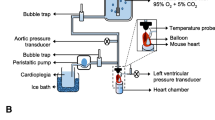Abstract
The goal of this study was to determine if an ischemic preconditioning (IPC) protocol improved post–ischemic functional recovery of female mouse hearts. A previous study found that IPC did not occur in hearts from 10–week–old females. We studied Langendorff–perfused hearts from both 10– and 18–week–old mice (males and females). Hearts were subjected to 45 min ischemia and 45 reperfusion (I/R); IPC involved pretreatment with 3 min ischemia. We measured hemodynamics, infarct size and levels of the phosphorylated prosurvival kinase Akt (p–Akt). Similar to a previous study, for 10– week–old mice we found that the IPC protocol appreciably improved recovery of LV developed pressure (LVDP) for hearts from males but not females. However, for 18–week–old mice we found that the IPC protocol doubled the recovery of LVDP for both males and females. For both ages, hearts from females had greater recovery of LVDP and higher levels of p–Akt compared to males.
Conclusions
These findings are consistent with growing evidence that preconditioning induced by ischemia or other interventions can occur in hearts from females. However, for hearts from females, preconditioning depends on age. Moreover, consistent with previous studies, hearts from females have greater inherent resistance to ischemic injury, possibly involving increased signaling via p–Akt.
Similar content being viewed by others
References
Abete P, Testa G, Ferrara N, De Santis D, Capaccio P, Viati L, Calabrese C, Cacciatore F, Longobardi G, Condorelli M, Napoli C, Rengo F (2002) Cardioprotective effect of ischemic preconditioning is preserved in food–restricted senescent rats. Am J Physiol Heart Circ Physiol 282:H1978–H1987
Bae S, Zhang L (2005) Gender differences in cardioprotection against ischemia/ reperfusion injury in adult rat hearts: focus on AKT and PKC signaling. J Pharmacol Exp Ther 315:1125–1135
Camper–Kirby D, Welch S, Walker A, Shiraishi I, Setchell KD, Schaefer E, Kajstura J, Anversa P, Sussman MA (2001) Myocardial Akt activation and gender: increased nuclear activity in females versus males. Circ Res 88:1020–1027
Cave AC, Hearse DJ (1992) Ischaemic preconditioning and contractile function: studies with normothermic and hypothermic global ischaemia. J Mol Cell Cardiol 24:1113–1123
Cross HR, Lu L, Steenbergen C, Philipson KD, Murphy E (1998) Overexpression of the cardiac Na+/Ca2+ exchanger increases susceptibility to ischemia/ reperfusion injury in male, but not female, transgenic mice. Circ Res 83:1215–1223
Cross HR, Murphy E, Steenbergen C (2002) Ca2+ loading and adrenergic stimulation reveal male/female differences in susceptibility to ischemia–reperfusion injury. Am J Physiol Heart Circ Physiol 283:H481–H489
Dai W, Kloner RA (2003) Effects of acetaminophen on myocardial infarct size in rats. J Cardiovasc Pharmacol Ther 8:277–284
Hale SL, Birnbaum Y, Kloner RA (1996) beta–Estradiol, but not alpha–estradiol, reduced myocardial necrosis in rabbits after ischemia and reperfusion. Am Heart J 132:258–262
Hearse DJ, Sutherland FJ (1999) Catecholamines and preconditioning: studies of contraction and function in isolated rat hearts. Am J Physiol 277:H136–H143
Humphreys RA, Kane KA, Parratt JR (1999) The influence of maturation and gender on the anti–arrhythmic effect of ischaemic preconditioning in rats. Basic Res Cardiol 94:1–8
Jin ZQ, Zhou HZ, Zhu P, Honbo N, Mochly–Rosen D, Messing RO, Goetzl EJ, Karliner JS, Gray MO (2002) Cardioprotection mediated by sphingosine–1–phosphate and ganglioside GM–1 in wild–type and PKC epsilon knockout mouse hearts. Am J Physiol Heart Circ Physiol 282:H1970–H1977
Kim YD, Chen B, Beauregard J, Kouretas P, Thomas G, Farhat MY, Myers AK, Lees DE (1996) 17 beta–Estradiol prevents dysfunction of canine coronary endothelium and myocardium and reperfusion arrhythmias after brief ischemia/reperfusion. Circulation 94:2901–2908
Kolodgie FD, Farb A, Litovsky SH, Narula J, Jeffers LA, Lee SJ, Virmani R (1997) Myocardial protection of contractile function after global ischemia by physiologic estrogen replacement in the ovariectomized rat. J Mol Cell Cardiol 29:2403–2414
Li Y, Kloner RA (1992) Cardioprotective effects of ischaemic preconditioning are not mediated by prostanoids. Cardiovasc Res 26:226–231
Mocanu MM, Bell RM, Yellon DM (2002) PI3 kinase and not p42/p44 appears to be implicated in the protection conferred by ischemic preconditioning. J Mol Cell Cardiol 34:661–668
Morrison RR, Jones R, Byford AM, Stell AR, Peart J, Headrick JP, Matherne GP (2000) Transgenic overexpression of cardiac A(1) adenosine receptors mimics ischemic preconditioning. Am J Physiol Heart Circ Physiol 279:H1071–H1078
Murry CE, Jennings RB, Reimer KA (1986) Preconditioning with ischemia: a delay of lethal cell injury in ischemic myocardium. Circulation 74:1124–1136
Murry CE, Richard VJ, Reimer KA, Jennings RB (1990) Ischemic preconditioning slows energy metabolism and delays ultrastructural damage during a sustained ischemic episode. Circ Res 66:913–931
Node K, Kitakaze M, Kosaka H, Minamino T, Funaya H, Hori M (1997) Amelioration of ischemia– and reperfusion– induced myocardial injury by 17beta–estradiol: role of nitric oxide and calcium–activated potassium channels. Circulation 96:1953–1963
Parratt J, Vegh A (1994) Pronounced antiarrhythmic effects of ischemic preconditioning. Cardioscience 5:9–18
Sbarouni E, Iliodromitis EK, Bofilis E, Kyriakides ZS, Kremastinos DT (1998) Short–term estrogen reduces myocardial infarct size in oophorectomized female rabbits in a dose–dependent manner. Cardiovasc Drugs Ther 12:457–462
Shinmura K, Nagai M, Tamaki K, Bolli R (2004) Gender and aging do not impair opioid–induced late preconditioning in rats. Basic Res Cardiol 99:46–55
Song X, Li G, Vaage J, Valen G (2003) Effects of sex, gonadectomy, and oestrogen substitution on ischaemic preconditioning and ischaemia–reperfusion injury in mice. Acta Physiol Scand 177:459–466
Sugishita K, Su Z, Li F, Philipson KD, Barry WH (2001) Gender influences [Ca2+]i during metabolic inhibition in myocytes overexpressing the Na+–Ca2+ exchanger. Circulation 104:2101–2106
Turnbull L, McCloskey DT, O’Connell TD, Simpson PC, Baker AJ (2003) Alpha 1–adrenergic receptor responses in alpha 1AB–AR knockout mouse hearts suggest the presence of alpha 1D–AR. Am J Physiol Heart Circ Physiol 284:H1104–H1109
Wang M, Baker L, Tsai BM, Meldrum KK, Meldrum DR (2005) Sex differences in the myocardial inflammatory response to ischemia–reperfusion injury. Am J Physiol Endocrinol Metab 288:E321–E326
Author information
Authors and Affiliations
Corresponding author
Rights and permissions
About this article
Cite this article
Turcato, S., Turnbull, L., Wang, GY. et al. Ischemic preconditioning depends on age and gender. Basic Res Cardiol 101, 235–243 (2006). https://doi.org/10.1007/s00395-006-0585-4
Received:
Revised:
Accepted:
Published:
Issue Date:
DOI: https://doi.org/10.1007/s00395-006-0585-4



